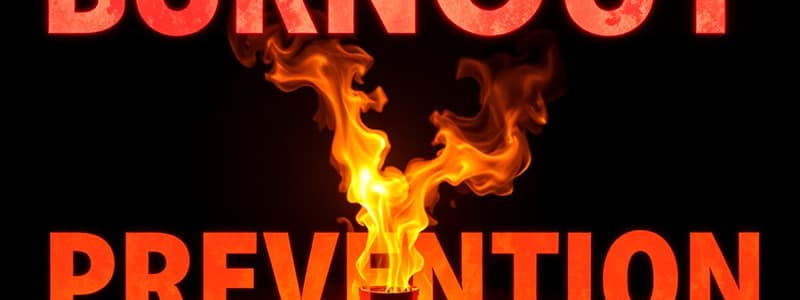Podcast
Questions and Answers
Burnout is a condition that only affects blue-collar workers.
Burnout is a condition that only affects blue-collar workers.
False (B)
Physical fatigue associated with burnout includes a lack of energy and low vitality.
Physical fatigue associated with burnout includes a lack of energy and low vitality.
True (A)
Superpeople are characterized by their desire to delegate tasks to others.
Superpeople are characterized by their desire to delegate tasks to others.
False (B)
Excessive demands and pressure can lead to both overload and underload stress.
Excessive demands and pressure can lead to both overload and underload stress.
The term 'Karoshi' translates to 'death from overwork' in Japanese.
The term 'Karoshi' translates to 'death from overwork' in Japanese.
Job performance improves when stress levels are either too low or too high.
Job performance improves when stress levels are either too low or too high.
Women with young children represent the fastest-growing segment of the American workforce.
Women with young children represent the fastest-growing segment of the American workforce.
Emergency aid for burnout can include taking a physical retreat.
Emergency aid for burnout can include taking a physical retreat.
Stress-resistant individuals often lack a sense of control in their lives.
Stress-resistant individuals often lack a sense of control in their lives.
Tertiary prevention in job stress interventions focuses on correcting the fundamental causes of stress.
Tertiary prevention in job stress interventions focuses on correcting the fundamental causes of stress.
Listening to feelings shows respect and may yield important information.
Listening to feelings shows respect and may yield important information.
Accepting consequences is not a part of responsibility during change.
Accepting consequences is not a part of responsibility during change.
Having an open mind and focusing on possibilities is crucial for exploration.
Having an open mind and focusing on possibilities is crucial for exploration.
Brainstorming ideas and alternatives is an effective way to cope with change.
Brainstorming ideas and alternatives is an effective way to cope with change.
Modeling and reinforcing positive actions is not important when dealing with change.
Modeling and reinforcing positive actions is not important when dealing with change.
Celebrating accomplishments can help prepare for future challenges.
Celebrating accomplishments can help prepare for future challenges.
Saying goodbye to the past is not necessary when resolving to improve.
Saying goodbye to the past is not necessary when resolving to improve.
Providing helpful training is a responsibility of those supporting an individual's change process.
Providing helpful training is a responsibility of those supporting an individual's change process.
Learning from the past is irrelevant to commitment.
Learning from the past is irrelevant to commitment.
Channeling energy in a helpful way is a part of coping strategies.
Channeling energy in a helpful way is a part of coping strategies.
Changing tasks in the workplace is typically driven by customer preferences and quality initiatives.
Changing tasks in the workplace is typically driven by customer preferences and quality initiatives.
Survivor syndrome occurs when employees who remain after downsizing feel confident and secure in their positions.
Survivor syndrome occurs when employees who remain after downsizing feel confident and secure in their positions.
Having a positive attitude towards lifelong learning is essential for remaining viable in the workplace.
Having a positive attitude towards lifelong learning is essential for remaining viable in the workplace.
Middle management typically feels supported in implementing organizational changes.
Middle management typically feels supported in implementing organizational changes.
People tend to resist change if it disrupts their personal lives or sense of control.
People tend to resist change if it disrupts their personal lives or sense of control.
The first step in Kurt Lewin’s three-step process of change is called freezing.
The first step in Kurt Lewin’s three-step process of change is called freezing.
Creating short-term wins during the change process is irrelevant to long-term success.
Creating short-term wins during the change process is irrelevant to long-term success.
To effectively deal with change, individuals should ignore the loss of direction and security.
To effectively deal with change, individuals should ignore the loss of direction and security.
Training employees is crucial for empowering them to adapt to change and enhancing their contribution.
Training employees is crucial for empowering them to adapt to change and enhancing their contribution.
Increased reliance on institutional help is considered a dominant trend in today's workplace.
Increased reliance on institutional help is considered a dominant trend in today's workplace.
Flashcards
Listen and acknowledge feelings.
Listen and acknowledge feelings.
Acknowledging and respecting someone's feelings by actively listening to what they are saying.
Say this is intolerable.
Say this is intolerable.
Expressing strong disapproval or objection to a situation or behavior.
Model and reinforce positive actions.
Model and reinforce positive actions.
Creating a positive environment by modeling and reinforcing desired behaviors.
Be patient.
Be patient.
Signup and view all the flashcards
Say good-bye to the past.
Say good-bye to the past.
Signup and view all the flashcards
Be willing to alter behavior.
Be willing to alter behavior.
Signup and view all the flashcards
Have an open mind.
Have an open mind.
Signup and view all the flashcards
Focus on possibilities.
Focus on possibilities.
Signup and view all the flashcards
Have courage.
Have courage.
Signup and view all the flashcards
Accept the consequences.
Accept the consequences.
Signup and view all the flashcards
Burnout
Burnout
Signup and view all the flashcards
Resistance to Change
Resistance to Change
Signup and view all the flashcards
Adaptive Capacity
Adaptive Capacity
Signup and view all the flashcards
Hardy Personality
Hardy Personality
Signup and view all the flashcards
Lewin's Change Model
Lewin's Change Model
Signup and view all the flashcards
Guiding Coalition
Guiding Coalition
Signup and view all the flashcards
Communicating Change Vision
Communicating Change Vision
Signup and view all the flashcards
Diffusion of Innovation
Diffusion of Innovation
Signup and view all the flashcards
Empowering People for Change
Empowering People for Change
Signup and view all the flashcards
Positive Attitude in Change
Positive Attitude in Change
Signup and view all the flashcards
Workaholic
Workaholic
Signup and view all the flashcards
Job Stress
Job Stress
Signup and view all the flashcards
Spiritual Fatigue
Spiritual Fatigue
Signup and view all the flashcards
Physical Fatigue
Physical Fatigue
Signup and view all the flashcards
Psychological Fatigue
Psychological Fatigue
Signup and view all the flashcards
Resilience
Resilience
Signup and view all the flashcards
Occupational Overload
Occupational Overload
Signup and view all the flashcards
Occupational Underload
Occupational Underload
Signup and view all the flashcards
Wellness Programs
Wellness Programs
Signup and view all the flashcards
Study Notes
Chapter 17: Helping People Through Change and Burnout Prevention
- This chapter discusses helping individuals navigate change and preventing burnout.
- Learning objectives include understanding how leaders can facilitate change, identifying burnout stages and interventions, recognizing hardy personalities, and assessing adaptive capacity.
- Types of workplace change include structural, task-related, technological, and interpersonal/individual changes.
- Stressful workplace changes include downsizing and reorganization, with accompanying effects like survivor syndrome.
- Lessons learned from organizational change suggest flexibility, positive attitudes towards lifelong learning, and the importance of career development.
- Organizational response to change varies across management levels (top management, middle management, and frontline employees).
- Top management may underestimate change impact, expecting compliance and blaming others for resistance.
- Middle management often lacks information and direction, feeling squeezed between resistant employees and demanding superiors.
- Frontline employees may feel threatened by change, responding with denial, resistance, and protective behaviors.
- People judge changes based on their personal impact. Loss of control is a significant concern during change.
- Guidelines for leaders in change efforts emphasize clear communication, thoughtful implementation, respecting those involved, recognizing contributions, patience, and listening.
- Kurt Lewin's three-step process for change management involves unfreezing (reducing resistance), moving to the desired state (communication), and refreezing (sustaining changes).
- Ron Heifetz and Don Laurie stress the leader's role in determining the pace and sequence of change.
- This includes clear communication, presence, and reducing unnecessary stress.
- The eight-stage process of creating major organizational change includes establishing urgency, forming a guiding force, developing a vision and strategy, communicating the vision, empowering action, removing obstacles, creating short-term wins, and anchoring change in culture.
- Common errors in organizational change efforts include complacency, weak coalitions, underestimating vision importance, poor vision communication, blocking change, lack of short-term wins, premature victory declarations, and neglecting cultural integration.
- Consequences of common change errors include poor strategy implementation, failed synergies, prolonged/expensive reengineering, uncontrolled downsizing, and ineffective quality programs.
- Empowering employees to effect change involves clearly communicating a compelling vision, aligning structures with that vision, providing necessary training, and addressing resistance.
- The importance of attitude emphasizes how an individual's approach to change substantially affects outcomes.
- A typical attitude curve in response to change involves denial, resistance, attitude trough, exploration, responsibility, and commitment.
- Strategies for dealing with change include recognizing losses like security, confidence, and direction, fostering a healthy coping mechanism, adopting a positive outlook, and addressing attitudes through tailored individual and collective strategies.
- Characteristics of burnout include physical, psychological, and spiritual exhaustion, stemming from excessive demands on one's resources.
- Types of burnout victims include superpeople, workaholics, burned-out Samaritans, mismatched employees, mid-career individuals, and overstressed students.
- Burnout is a significant workplace concern.
- Steps in a typical path to burnout include enthusiasm, slowdown, stagnation, and apathy.
- Strategies for dealing with burnout encompass emergency aid, short-term actions, and long-term solutions.
- Leaders play a crucial role in preventing burnout through clarifying the organization's purpose, role expectations, creating a safe work environment, maintaining an appropriate workload balance between continuity and change, and supporting a culture of teamwork
- Strategies to support these initiatives consist of flexibility, opportunity for participation in decisions impacting workers, career development policies, and assistance during challenging times.
- Common stress sources in the workplace include new technology, workforce diversification, global competition, organizational restructuring, and changes to work processes.
- Occupational overload and underload negatively impact job performance, with moderate arousal levels producing optimal results.
- Public policy aims to support well-designed jobs, evaluating systems for psychological disorders, educating workers on stress, and enhancing mental health services.
- The Karoshi syndrome encompasses workplace behaviors resulting in overwork death.
- Women experience specific workplace stress related to home and work demands.
- Executive monkey studies highlight the detrimental effects of responsibility and stress on health.
- The Weiss study emphasizes the impact of uncontrollable pressure on health.
- Job stress interventions, involving primary, secondary, and tertiary prevention, prioritize early identification and treatment of burnout.
- Wellness programs, ranging from basic awareness programs to focused training and comprehensive support systems, can aid in mitigating workplace pressures.
- Stress-resistant individuals exhibit adaptive capacity, embracing challenges, exhibiting self-control, and maintaining an overall balanced outlook.
- Resilience, grounded in the hardy personality's characteristics (personal commitment, sense of control, positive attitude, balanced perspective, and caring relationships), are essential for effectively managing change and stress, promoting well-being, and maximizing individual potential.
Studying That Suits You
Use AI to generate personalized quizzes and flashcards to suit your learning preferences.



